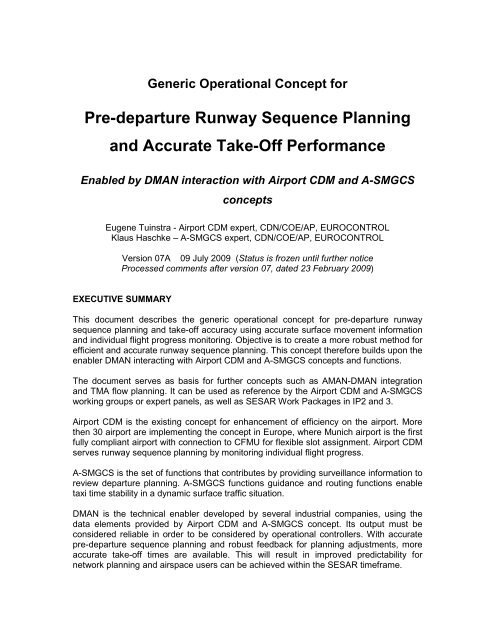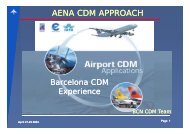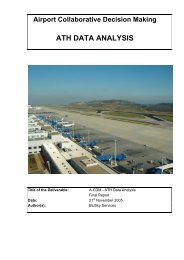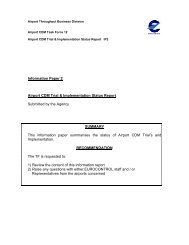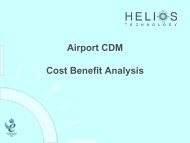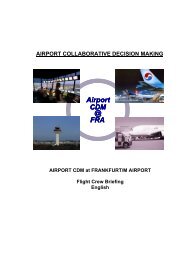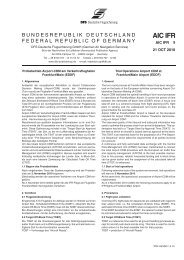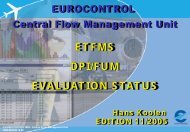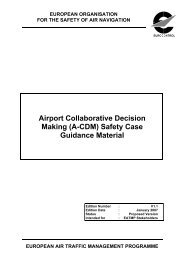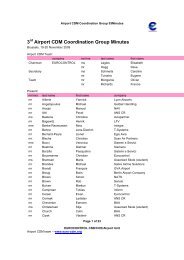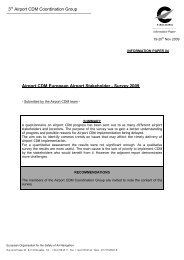Generic Operational Concept for DMAN Interaction v07A - Airport ...
Generic Operational Concept for DMAN Interaction v07A - Airport ...
Generic Operational Concept for DMAN Interaction v07A - Airport ...
Create successful ePaper yourself
Turn your PDF publications into a flip-book with our unique Google optimized e-Paper software.
<strong>Generic</strong> <strong>Operational</strong> <strong>Concept</strong> <strong>for</strong><br />
Pre-departure Runway Sequence Planning<br />
and Accurate Take-Off Per<strong>for</strong>mance<br />
Enabled by <strong>DMAN</strong> interaction with <strong>Airport</strong> CDM and A-SMGCS<br />
concepts<br />
Eugene Tuinstra - <strong>Airport</strong> CDM expert, CDN/COE/AP, EUROCONTROL<br />
Klaus Haschke – A-SMGCS expert, CDN/COE/AP, EUROCONTROL<br />
Version 07A 09 July 2009 (Status is frozen until further notice<br />
Processed comments after version 07, dated 23 February 2009)<br />
EXECUTIVE SUMMARY<br />
This document describes the generic operational concept <strong>for</strong> pre-departure runway<br />
sequence planning and take-off accuracy using accurate surface movement in<strong>for</strong>mation<br />
and individual flight progress monitoring. Objective is to create a more robust method <strong>for</strong><br />
efficient and accurate runway sequence planning. This concept there<strong>for</strong>e builds upon the<br />
enabler <strong>DMAN</strong> interacting with <strong>Airport</strong> CDM and A-SMGCS concepts and functions.<br />
The document serves as basis <strong>for</strong> further concepts such as AMAN-<strong>DMAN</strong> integration<br />
and TMA flow planning. It can be used as reference by the <strong>Airport</strong> CDM and A-SMGCS<br />
working groups or expert panels, as well as SESAR Work Packages in IP2 and 3.<br />
<strong>Airport</strong> CDM is the existing concept <strong>for</strong> enhancement of efficiency on the airport. More<br />
then 30 airport are implementing the concept in Europe, where Munich airport is the first<br />
fully compliant airport with connection to CFMU <strong>for</strong> flexible slot assignment. <strong>Airport</strong> CDM<br />
serves runway sequence planning by monitoring individual flight progress.<br />
A-SMGCS is the set of functions that contributes by providing surveillance in<strong>for</strong>mation to<br />
review departure planning. A-SMGCS functions guidance and routing functions enable<br />
taxi time stability in a dynamic surface traffic situation.<br />
<strong>DMAN</strong> is the technical enabler developed by several industrial companies, using the<br />
data elements provided by <strong>Airport</strong> CDM and A-SMGCS concept. Its output must be<br />
considered reliable in order to be considered by operational controllers. With accurate<br />
pre-departure sequence planning and robust feedback <strong>for</strong> planning adjustments, more<br />
accurate take-off times are available. This will result in improved predictability <strong>for</strong><br />
network planning and airspace users can be achieved within the SESAR timeframe.
<strong>Generic</strong> <strong>Operational</strong> <strong>Concept</strong> <strong>for</strong> Pre-departure Runway Sequence Planning and<br />
Accurate Take-Off Per<strong>for</strong>mance<br />
Enabled by <strong>DMAN</strong> interaction with <strong>Airport</strong> CDM and A-SMGCS concepts<br />
Content<br />
1. INTRODUCTION......................................................................................................3<br />
1.1 Document ........................................................................................................3<br />
1.2 Purpose ...........................................................................................................3<br />
1.3 Background and Relevant <strong>Concept</strong>s................................................................3<br />
1.3.1 A-SMGCS ....................................................................................................3<br />
1.3.2 <strong>Airport</strong> CDM .................................................................................................4<br />
1.3.3 <strong>DMAN</strong> ..........................................................................................................4<br />
1.4 Justification......................................................................................................5<br />
1.4.1 History..........................................................................................................5<br />
1.4.2 Expected benefits ........................................................................................5<br />
1.4.3 SESAR Target based behaviour ..................................................................7<br />
1.4.4 Need <strong>for</strong> <strong>Interaction</strong> of <strong>Concept</strong>s and applied Enablers................................7<br />
1.4.5 Enabler to increased runway throughput......................................................7<br />
1.4.6 Pre-requisite <strong>for</strong> mixed-mode operations......................................................8<br />
1.4.7 Pre-requisite <strong>for</strong> TMA and ACC planning .....................................................8<br />
1.4.8 Pre-requisite <strong>for</strong> European Network planning...............................................9<br />
1.4.9 Support to Global <strong>Concept</strong> and Definition Harmonisation.............................9<br />
2. GENERIC OPERATIONAL CONCEPT ..................................................................10<br />
2.1 Scope ............................................................................................................10<br />
2.2 Timeframe .....................................................................................................10<br />
2.3 Objectives......................................................................................................10<br />
2.4 High level <strong>Operational</strong> <strong>Concept</strong>......................................................................11<br />
2.4.1 <strong>Airport</strong> Operator Perspective......................................................................12<br />
2.4.2 Controller Perspective................................................................................12<br />
2.4.3 Planning Philosophy...................................................................................16<br />
2.4.4 Planning Optimisation ................................................................................16<br />
2.4.5 Planning Timeline ......................................................................................17<br />
2.4.6 Network Need <strong>for</strong> Take-Off predictions ......................................................19<br />
2.4.7 Flight Crew Perspective .............................................................................21<br />
2.4.8 <strong>DMAN</strong> as enabler <strong>for</strong> <strong>Operational</strong> <strong>Concept</strong> procedures..............................22<br />
3. CONCLUSIONS.....................................................................................................25<br />
4. OPERATIONAL REQUIREMENTS ........................................................................26<br />
4.1 <strong>Generic</strong> <strong>Operational</strong> Principles.......................................................................26<br />
4.2 Detailed <strong>Operational</strong> Requirements <strong>for</strong> <strong>DMAN</strong>...............................................27<br />
4.3 Implementation Steps ....................................................................................27<br />
Page 2 of 29<br />
EUROCONTROL HQ, Cooperative Network Design, Centre of Expertise, <strong>Airport</strong>s Unit
<strong>Generic</strong> <strong>Operational</strong> <strong>Concept</strong> <strong>for</strong> Pre-departure Runway Sequence Planning and<br />
Accurate Take-Off Per<strong>for</strong>mance<br />
Enabled by <strong>DMAN</strong> interaction with <strong>Airport</strong> CDM and A-SMGCS concepts<br />
1. INTRODUCTION<br />
1.1 Document<br />
This document describes the generic operational concept <strong>for</strong> pre-departure runway<br />
sequence planning and take-off accuracy using accurate surface movement in<strong>for</strong>mation<br />
and individual flight progress monitoring. Objective is to create a more robust method <strong>for</strong><br />
efficient and accurate runway sequence planning. This concept there<strong>for</strong>e builds upon the<br />
enabler <strong>DMAN</strong> interacting with <strong>Airport</strong> CDM and A-SMGCS concepts and functions.<br />
This document is the output of two workshops held in EUROCONTROL HQ, Brussels<br />
(references 4 and 5), which aimed to determine a definition of <strong>DMAN</strong>. <strong>Airport</strong><br />
stakeholders and industry used operational use cases to derive the definition, which<br />
<strong>for</strong>ms the basis <strong>for</strong> deriving this concept.<br />
This concept is written in line with the SESAR Work Program (reference 1) and SESAR<br />
Target ATM <strong>Concept</strong> (reference 2). The document is providing a clear indication where<br />
the concept refers to SESAR Implementation Packages in order to allow <strong>for</strong> stepwise<br />
implementation or validation activities.<br />
The document serves as basis <strong>for</strong> further concepts such as AMAN-<strong>DMAN</strong> integration<br />
and TMA flow planning. It can be used as reference by the <strong>Airport</strong> CDM and A-SMGCS<br />
working groups or expert panels, as well as SESAR Work Packages in IP2 and 3.<br />
1.2 Purpose<br />
This generic operational concept aims to provide a coherent view on the implementation<br />
of <strong>DMAN</strong> <strong>for</strong> the purpose of reliable and robust departure sequencing <strong>for</strong> large airports<br />
with high density traffic volumes. It integrates existing concepts <strong>for</strong> <strong>Airport</strong> CDM and A-<br />
SMGCS, including their ongoing research developments in recent projects and SESAR,<br />
in order to facilitate achieving the expected benefits.<br />
The document is providing a generic operational concept applicable to any airport<br />
globally. It aims to be applicable <strong>for</strong> all SESAR Implementation Packages, as its content<br />
can be considered a prerequisite <strong>for</strong> enhanced runway in mixed mode use or TMA<br />
operational concepts.<br />
1.3 Background and Relevant <strong>Concept</strong>s<br />
1.3.1 A-SMGCS<br />
In A-SMGCS two functions are currently validated:<br />
1. Surveillance<br />
2. Control - Safety nets (e.g. Runway Incursion)<br />
Other more advanced functions such as Routing and Guidance (Navigation) are,<br />
although still under research and development, included in this document to serve the<br />
concept objectives.<br />
Page 3 of 29<br />
EUROCONTROL HQ, Cooperative Network Design, Centre of Expertise, <strong>Airport</strong>s Unit
<strong>Generic</strong> <strong>Operational</strong> <strong>Concept</strong> <strong>for</strong> Pre-departure Runway Sequence Planning and<br />
Accurate Take-Off Per<strong>for</strong>mance<br />
Enabled by <strong>DMAN</strong> interaction with <strong>Airport</strong> CDM and A-SMGCS concepts<br />
A-SMGCS level 1 intends primarily to enhance safety and efficiency of ground surface<br />
operations through the introduction of cooperative and non-cooperative sensors. Visual<br />
“Out of the Window View” is supplemented by an automated surveillance system with<br />
the aim of maintaining safety and capacity in low visibility. However, with A-SMGCS level<br />
1, the actual movements of aircraft can be recorded, which allows <strong>for</strong> accurate<br />
measurements of actual off-blocks and take-off times, as well as taxi times.<br />
A-SMGCS level 2 intends to enhance safety on and near runways, using safety bars and<br />
incursion detection and alerting technology <strong>for</strong> both tower controllers and flight crews.<br />
In the future, A-SMGCS functions such as routing, control and guidance will be useful to<br />
support flight crews with functions to navigate on the surface more easily, and smooth<br />
the taxi flows from stands to runways in order to deliver the actual take-off sequence<br />
according to the planning. However although these functions are defined by ICAO,<br />
validation is still in progress on various sites.<br />
1.3.2 <strong>Airport</strong> CDM<br />
<strong>Airport</strong> Collaborative Decision Making is the concept which aims at improving Air Traffic<br />
Flow and Capacity Management (ATFCM) at airports by reducing delays, improving the<br />
predictability of events and optimising the utilisation of resources and infrastructure.<br />
Implementation of <strong>Airport</strong> CDM allows each <strong>Airport</strong> CDM Partner to optimise their<br />
decisions based on in<strong>for</strong>mation sharing with other <strong>Airport</strong> CDM Partners, being in<strong>for</strong>med<br />
about their preferences and constraints and the actual and predicted situation.<br />
The decision making by the <strong>Airport</strong> CDM Partners is facilitated by the sharing of accurate<br />
and timely in<strong>for</strong>mation and by adapted procedures, mechanisms and tools.<br />
The <strong>Airport</strong> CDM concept is divided in the following concept elements:<br />
1. In<strong>for</strong>mation Sharing<br />
2. Milestone Approach<br />
3. Variable Taxi Time<br />
4. Pre-departure Sequencing<br />
5. Adverse Conditions<br />
6. Collaborative Management of Flight Updates<br />
These concept elements are ordered in the recommended way of implementation, as<br />
each element depends on the previous element to be in place. Note that <strong>Airport</strong> CDM is<br />
also the name of the EUROCONTROL project coordinating the implementation of the<br />
<strong>Airport</strong> CDM concept at ECAC airports. This project is part of the DMEAN and SESAR<br />
programs and is used in preparation <strong>for</strong> a Community Specification by the European<br />
Commission.<br />
1.3.3 <strong>DMAN</strong><br />
<strong>DMAN</strong> is commercially available today as a technical product sold by industry, often as a<br />
conceptual and complete solution <strong>for</strong> departure management on airports. Most likely this<br />
is the case in combination with an Arrival Manager (AMAN) as an integrated runway<br />
management solution <strong>for</strong> optimising throughput on runways and the airport surface.<br />
Page 4 of 29<br />
EUROCONTROL HQ, Cooperative Network Design, Centre of Expertise, <strong>Airport</strong>s Unit
<strong>Generic</strong> <strong>Operational</strong> <strong>Concept</strong> <strong>for</strong> Pre-departure Runway Sequence Planning and<br />
Accurate Take-Off Per<strong>for</strong>mance<br />
Enabled by <strong>DMAN</strong> interaction with <strong>Airport</strong> CDM and A-SMGCS concepts<br />
However, as each industrial partner defined its own set of acronyms, definitions and<br />
unique functionality, with increasing diversity between products <strong>for</strong> a similar range of<br />
surface traffic problems on airports, a need <strong>for</strong> harmonisation has grown.<br />
Following the two <strong>DMAN</strong> workshops on 22 February 2008 (reference 4) and 12-13 June<br />
2008 (reference 5) a definition <strong>for</strong> the term <strong>DMAN</strong> was accepted by operational<br />
stakeholders and industrial partners:<br />
<strong>DMAN</strong> is a planning system to improve departure flows at an<br />
airport by calculating the Target Take Off Time (TTOT) and Target<br />
Start-up Approval Time (TSAT) <strong>for</strong> each flight, taking multiple<br />
constraints and preferences into account.<br />
This definition is in line with the <strong>Airport</strong> CDM concept, and supports the functionality of<br />
the <strong>DMAN</strong> type of products already available in the market. It allows <strong>for</strong> coupling to<br />
AMAN and surface management products, as well as with TMA planning enablers in the<br />
future.<br />
1.4 Justification<br />
1.4.1 History<br />
Since the nineties many research projects funded by the European Commission have<br />
investigated different types of departure and surface management concepts in different<br />
airport environments. Key projects that <strong>for</strong>m the basis of this report are, among others:<br />
• AFAS (5 th framework, reference 8),<br />
• Gate-to-Gate (5 th framework, reference 15),<br />
• Leonardo (5 th framework, reference 16),<br />
• NUP2+ (reference 14),<br />
• BETA (5 th framework, reference 9),<br />
• EMMA (6 th framework, reference 10),<br />
• EMMA 2 (6 th framework, ongoing, reference 11),<br />
• ITWP (reference 12)<br />
A common result of many simulations and studies was that more accurate traffic<br />
planning is possible by replacing today’s first-come-first-served principle, by on-time<br />
service provision or by optimised cost service provision (prioritisation), could lead to<br />
large benefits <strong>for</strong> stakeholders in terms of efficiency, environment, capacity, and safety.<br />
These expectations have led the industry to develop planning tools like <strong>DMAN</strong>, SMAN,<br />
AMAN etc. However, these tools often lack interaction and common acronyms as well as<br />
a coherent operational concept. This generic operational concept aims to fill this gap and<br />
integrate accomplished research results and industry products in the defined SESAR<br />
implementation packages IP1 and IP2.<br />
1.4.2 Expected benefits<br />
Based on years of operational validation at several European airports it was concluded<br />
that flight sequencing from off-block and take-off events, based on accurate off-block<br />
prediction by the Aircraft Operator and/or Ground Handler, can reduce runway queue<br />
times, and hence actual taxi times significantly. That leads to the following primary<br />
Page 5 of 29<br />
EUROCONTROL HQ, Cooperative Network Design, Centre of Expertise, <strong>Airport</strong>s Unit
<strong>Generic</strong> <strong>Operational</strong> <strong>Concept</strong> <strong>for</strong> Pre-departure Runway Sequence Planning and<br />
Accurate Take-Off Per<strong>for</strong>mance<br />
Enabled by <strong>DMAN</strong> interaction with <strong>Airport</strong> CDM and A-SMGCS concepts<br />
benefits which are common over the existing concepts <strong>for</strong> A-SMGCS and <strong>Airport</strong> CDM<br />
(in brackets the beneficial party):<br />
• Increased operational efficiency, by:<br />
o Improved adherence to the flight schedule (Aircraft Operator)<br />
o Improved predictability of in- and off-block times (<strong>Airport</strong> Operator,<br />
Ground Handlers)<br />
o Reduced taxi times (Aircraft Operator)<br />
o Improved airport throughput (<strong>Airport</strong> Operator)<br />
o Reduced fuel consumption (Aircraft Operator), and;<br />
o Stabilised traffic flows (ATC)<br />
• Improved environment, by:<br />
o Reduced fuel emissions (global warming and local air quality), and;<br />
o Reduced noise (residents around airport and airport employees)<br />
• Enhanced utilisation of ATM network, by:<br />
o Improved prediction of estimates of Take Off Time leading to an<br />
enhancement in the ATM Network<br />
o Increased number of utilized slots (CFMU, ATC), and;<br />
o Reduced number of regulated slots (CFMU, Aircraft Operator)<br />
• Increased safety, by:<br />
o Reduced workload (ATC), and;<br />
o Reduced stress and disorder during the turn-round process (Ground<br />
Handler, Aircraft Operator)<br />
The interaction of A-SMGCS, <strong>Airport</strong> CDM and <strong>DMAN</strong> increases those primary benefits<br />
due to synergies of the individual concepts, resulting in the following secondary benefits:<br />
• Improved transparency, by:<br />
o More frequent planning updates, accessible by users: An overview on<br />
planned departure sequencing will increase the situational awareness of<br />
all partners involved.<br />
• Increased flexibility, by:<br />
o Allowing Aircraft Operators to modify the planning of their own flights in<br />
the pre-departure sequence based on planned flight scheduling and<br />
aircraft fleet use.<br />
• Improved traceability, by:<br />
o Event recording and monitoring: A recording of planning updates and their<br />
consequences will increase per<strong>for</strong>mance assessment capabilities and<br />
options to analyse optimisation in decision making.<br />
• Enhanced interaction, by:<br />
o Allowing all partners to follow the departure sequence planning, to give<br />
them what-if probing facilities which could become beneficial to planning<br />
convergence and reduction of controller workload.<br />
These primary and secondary benefits will be dealt with in the following sections and<br />
chapters.<br />
Page 6 of 29<br />
EUROCONTROL HQ, Cooperative Network Design, Centre of Expertise, <strong>Airport</strong>s Unit
<strong>Generic</strong> <strong>Operational</strong> <strong>Concept</strong> <strong>for</strong> Pre-departure Runway Sequence Planning and<br />
Accurate Take-Off Per<strong>for</strong>mance<br />
Enabled by <strong>DMAN</strong> interaction with <strong>Airport</strong> CDM and A-SMGCS concepts<br />
1.4.3 SESAR Target based behaviour<br />
Despite the fact that the process of aircraft turn-round at an airport involves decision<br />
moments which will always contain a high level of uncertainty, a pro-active concept of<br />
prediction and updating predictions will be more beneficial than a reactive first-comefirst-served<br />
concept as it is maintained today. The SESAR business trajectory oriented<br />
approach, leading to a Required Time of Arrival (RTA) being targeted as the basis of the<br />
flight trajectory, requires more transparency on the predicting process of departure<br />
times.<br />
Without accurate, transparent and target oriented prediction of traffic flows combined<br />
with individual flight progress monitoring, the SESAR objectives of target (RTA) based<br />
planning using the business trajectory will be less feasible to achieve. Hence, this<br />
document is a pre-requisite <strong>for</strong> further target based planning concepts applicable on<br />
runway, in TMA and <strong>for</strong> the network, as is elaborated in the following sections.<br />
1.4.4 Need <strong>for</strong> <strong>Interaction</strong> of <strong>Concept</strong>s and applied Enablers<br />
In parallel to the a<strong>for</strong>ementioned European research projects, the <strong>Airport</strong> CDM<br />
implementation project in EUROCONTROL commenced in the year 2000 onwards, with<br />
the aim of enhancing operational efficiency by improving event predictability (reference<br />
6). Years of concept enhancements and operational experience during implementation<br />
at airports resulted in benefits similar to those mentioned above. In 2006 the synergy<br />
between <strong>Airport</strong> CDM and <strong>DMAN</strong> was identified, and aligned within the <strong>Airport</strong><br />
Operations division in EUROCONTROL with the justification that <strong>DMAN</strong> required a clear<br />
operational context and industrial harmonisation; and <strong>Airport</strong> CDM required technical<br />
enablers to per<strong>for</strong>m the tasks required by several concept elements.<br />
As several projects on either <strong>DMAN</strong> or <strong>Airport</strong> CDM validations produced more results, it<br />
became clear that data measurements of actual traffic events were the key to ensure<br />
accurate updates of plans made in earlier flight stages. As Advanced-Surface Movement<br />
Guidance & Control System (A-SMGCS, reference 7) provided the enablers <strong>for</strong> detecting<br />
actual events on the surface, the loop <strong>for</strong> accurate and correct planning through<br />
feedback of traffic events on the ground could be closed (see Figure 1).<br />
Plan Execute<br />
Adjust<br />
Figure 1: Planning cycle including feedback loop<br />
Measure<br />
Integrating airport surveillance in<strong>for</strong>mation into pre-departure planning is expected to<br />
contribute significantly to more reliable off-block and take-off prediction. This is an<br />
activity which relates directly to ongoing work in the EUROCONTROL program, which<br />
will continue under IP1 in SESAR.<br />
1.4.5 Enabler to increased runway throughput<br />
To contribute to optimised use of available capacity, the problems with today’s runway<br />
throughput needs to be identified. At least four limiting factors have a negative impact on<br />
the flexibility of the departure sequence:<br />
Page 7 of 29<br />
EUROCONTROL HQ, Cooperative Network Design, Centre of Expertise, <strong>Airport</strong>s Unit
<strong>Generic</strong> <strong>Operational</strong> <strong>Concept</strong> <strong>for</strong> Pre-departure Runway Sequence Planning and<br />
Accurate Take-Off Per<strong>for</strong>mance<br />
Enabled by <strong>DMAN</strong> interaction with <strong>Airport</strong> CDM and A-SMGCS concepts<br />
• Fleet mix (wake vortex, see references 14, 15, 20)<br />
• Limited number of SID routes per runway (separation, see reference 19)<br />
• Limited options of manoeuvring at the runway holding position (reference 10, 11)<br />
• Limited options of manoeuvring due to limited taxiway system (reference 10, 11)<br />
<strong>Airport</strong>s where one of these limiting factors applies will achieve more benefits from an<br />
integrated <strong>DMAN</strong> enabler, compared to airports that are more flexible. In constraint<br />
conditions the traffic flow towards the runway threshold needs to be more predictable <strong>for</strong><br />
ground and runway controllers, in order to anticipate earlier on potential inefficiencies,<br />
ensuring the most efficient sequence is actually delivered to the runway. Under flexible<br />
operational conditions these controllers are able to modify the sequence at a later stage,<br />
close to the runway threshold.<br />
Once the actual sequence is achieved with minimal deviation compared to the sequence<br />
planning, an increase of runway throughput in saturated traffic situations may be<br />
possible. This throughput is then enabled by <strong>DMAN</strong> calculation, which optimises the<br />
take-off sequence on wake vortex and SID separation values, especially when the<br />
infrastructure <strong>for</strong> runway access and utilisation is limited.<br />
1.4.6 Pre-requisite <strong>for</strong> mixed-mode operations<br />
AMAN-<strong>DMAN</strong> integration or Integrated Runway Management (IRM) solutions <strong>for</strong> the<br />
concept of high runway throughput, requires a sound basis <strong>for</strong> the delivery of departure<br />
flights at the runway threshold, in order to optimise the use of gaps between arrival<br />
flights.<br />
Accurate sequencing and delivery of sequenced aircraft by controllers to the runway<br />
enables to achieve the maximal throughput as planned by <strong>DMAN</strong>-AMAN, especially<br />
when the size of spacing between arrivals reflects the weight category of the planned<br />
departures.<br />
For this spacing planning by approach controllers in coordination with the tower, the<br />
amount and category of departures will be predicted accurately. To deliver the aircraft as<br />
planned, guidance of the aircraft during the taxi-out is essential. <strong>Airport</strong> CDM predeparture<br />
sequencing is the IP1 activity which contributes to this delivery. However<br />
airport routing and guidance aids developed in more advanced functions of A-SMGCS<br />
may contribute to even more precise delivery. This is however a development still<br />
ongoing and related to IP2 in SESAR.<br />
1.4.7 Pre-requisite <strong>for</strong> TMA and ACC planning<br />
Traffic delays in TMA or ACC sectors can be caused by aircraft departing from different<br />
airports in close proximity and merging at a certain waypoint in the TMA or ACC at the<br />
same time. This merging of flights, or bunching effect, can cause an increase in<br />
controller workload due to coordination and applying separation, which in turn can lead<br />
to an increase in delay.<br />
To mitigate the phenomenon of traffic bunching, flights with similar departure routes from<br />
different airports will be regulated on their take-off time. This regulation can be done with<br />
Minimum Departure Intervals (MDI) or by applying the Departure Metering concept<br />
Page 8 of 29<br />
EUROCONTROL HQ, Cooperative Network Design, Centre of Expertise, <strong>Airport</strong>s Unit
<strong>Generic</strong> <strong>Operational</strong> <strong>Concept</strong> <strong>for</strong> Pre-departure Runway Sequence Planning and<br />
Accurate Take-Off Per<strong>for</strong>mance<br />
Enabled by <strong>DMAN</strong> interaction with <strong>Airport</strong> CDM and A-SMGCS concepts<br />
(references 18 and 19). MDI’s however usually causes escalating delays at airports,<br />
whereas Departure Metering depends heavily on accurate take-off predictions.<br />
Delivery of taxiing aircraft to the runway according to the (pre-departure) planned runway<br />
sequence is considered essential to enable accurate TMA or ACC traffic predictions by<br />
Departure Metering of flights. This generic concept <strong>for</strong> surface and runway planning aims<br />
to enable flights to take off more accurately to their target take-off time (TTOT).<br />
1.4.8 Pre-requisite <strong>for</strong> European Network planning<br />
With a more reliable target take-off time, as described in the previous sections, the enroute<br />
network can enhance their en-route traffic predictions and sector counts with the<br />
purpose to reduce the number of regulations applied. Hence, this integrated concept<br />
supports the efficiency of the entire European ATM network.<br />
A study is per<strong>for</strong>med by EUROCONTROL Bretigny where the impact of more accurate<br />
take-off time predictions to network planning. Results can be found in reference 21.<br />
1.4.9 Support to Global <strong>Concept</strong> and Definition Harmonisation<br />
As other high congested regions or airspace develop similar concepts to enhance<br />
surface movements by applying more prediction and planning, it becomes essential to<br />
harmonise acronyms and standardise definitions <strong>for</strong> suppliers and users of existing and<br />
future products. This document initiates support to this harmonisation and<br />
standardisation, by referring to the main fundamentals <strong>Airport</strong> CDM and A-SMGCS, as<br />
referenced in 6 and 7.<br />
Page 9 of 29<br />
EUROCONTROL HQ, Cooperative Network Design, Centre of Expertise, <strong>Airport</strong>s Unit
<strong>Generic</strong> <strong>Operational</strong> <strong>Concept</strong> <strong>for</strong> Pre-departure Runway Sequence Planning and<br />
Accurate Take-Off Per<strong>for</strong>mance<br />
Enabled by <strong>DMAN</strong> interaction with <strong>Airport</strong> CDM and A-SMGCS concepts<br />
2. GENERIC OPERATIONAL CONCEPT<br />
2.1 Scope<br />
The scope of this generic operational concept focuses on surface movements of aircraft<br />
during the taxi-out phase, which is considered highly dynamic and there<strong>for</strong>e difficult to<br />
predict. Planning and accurately controlled execution of those movements on the<br />
aprons, taxiways, and runways requires an integrated view in order to achieve the<br />
expected benefits listed in section 1.4.2.<br />
This document does not discuss landside planning or airside ground handling traffic<br />
activities, nor does it refer to passenger or cargo flow planning. The document is also<br />
independent of any sequence optimisation methodology, as applied by industrial<br />
companies in their <strong>DMAN</strong> products.<br />
This document has strong interdependency with Arrival Management (AMAN) coupling<br />
to <strong>DMAN</strong> concepts, as well as TMA-ACC traffic flow optimisation, as described in<br />
references 1 and 3 and section 1.4.6. This document <strong>for</strong>ms an essential pre-requisite <strong>for</strong><br />
traffic planning in TMA departure metering, as mentioned in section 1.4.7. Also, there are<br />
dependencies on stand and gate management policies and constraints, as these may be<br />
stressed due this concept of departure management.<br />
2.2 Timeframe<br />
The applicable timeframe <strong>for</strong> this generic concept is defined in SESAR Implementation<br />
Packages (IP). <strong>Airport</strong> CDM and A-SMGCS functions Surveillance and Safety Nets, are<br />
implemented under IP1, and can be validated in operational experiments in near term<br />
projects. More advanced functions in A-SMGCS (see section 1.3.1) are planned <strong>for</strong><br />
implementation in IP2, and can be included in longer term validation activities under<br />
SESAR.<br />
2.3 Objectives<br />
With the scope and timeframe in consideration the concept objectives are derived <strong>for</strong><br />
<strong>DMAN</strong> interaction with <strong>Airport</strong> CDM and A-SMGCS. These concept objectives aim to be<br />
generic <strong>for</strong> any airport that considers implementing pre-departure off-block and runway<br />
sequencing of outbound flights into their operational environment. From these objectives<br />
and the concept that is derived from them, operational requirements can be considered<br />
as high level guidelines <strong>for</strong> implementation.<br />
1. Increase the quality of target take-off times<br />
a. Reduce the deviation from actual take-off compared to target take-off time<br />
b. Increase prediction horizon<br />
c. Enhance robustness of sequence planning against disturbances or<br />
adverse conditions<br />
d.<br />
2. Achieve expected <strong>Airport</strong> CDM and A-SMGCS derived benefits<br />
3. Enhance the reliability of the concepts and technical enablers<br />
a. Demonstrate feasibility of the technical enablers<br />
b. Establish acceptability of take-off sequencing by controllers<br />
Page 10 of 29<br />
EUROCONTROL HQ, Cooperative Network Design, Centre of Expertise, <strong>Airport</strong>s Unit
<strong>Generic</strong> <strong>Operational</strong> <strong>Concept</strong> <strong>for</strong> Pre-departure Runway Sequence Planning and<br />
Accurate Take-Off Per<strong>for</strong>mance<br />
Enabled by <strong>DMAN</strong> interaction with <strong>Airport</strong> CDM and A-SMGCS concepts<br />
In order to achieve these objectives, some important requirements need to be<br />
considered:<br />
• The concept shall be fully applicable <strong>for</strong> all airports where large traffic volumes,<br />
capacity saturation, or strong peak behaviour are applicable, and where similar<br />
preconditions (as per references 6 and 7) are implemented;<br />
• The concept shall be applicable as pre-requisite <strong>for</strong> TMA planning and mixed<br />
mode runway management (AMAN-<strong>DMAN</strong> coupling);<br />
• The concept shall be built on <strong>Airport</strong> CDM and A-SMGCS implementation<br />
concepts, as described in references 6 and 7.<br />
• The concept shall be mapped to stand and gate planning concepts, policies or<br />
constraints, as they potentially limit the applicability of this generic operational<br />
concept <strong>for</strong> <strong>DMAN</strong> interaction.<br />
2.4 High level <strong>Operational</strong> <strong>Concept</strong><br />
The foundation of pre-departure off-block and runway sequencing is to combine two<br />
types of interdependent processes via <strong>DMAN</strong>. By using this automated enabler the<br />
output results into feasible and robust planning which can be disseminated to the<br />
stakeholders, such as controllers, flight crews, ground handlers, Airline Operator staff,<br />
<strong>Airport</strong> Operator staff, and the network. These founding processes are:<br />
• Individual flight progress using <strong>Airport</strong> CDM Milestone Approach concept<br />
element on each active flight in any flight phase to or at the airport<br />
• Surface traffic situation using A-SMGCS functions 1 and 2 <strong>for</strong> all aircraft<br />
moving on the airport surface<br />
Individual flight progress captured by <strong>Airport</strong> CDM is the essence of any planning<br />
concept. The effects of planning one flight will have direct impact on other flights in the<br />
turn-round phase, since each requires ef<strong>for</strong>t and time of human and physical resources.<br />
The surface traffic situation determines throughput of the flows, and is highly dynamic.<br />
Many events can disturb the traffic flows, and hence has large impact on the predeparture<br />
off-block and runway sequence planning.<br />
In this section a high level concept is outlined under different aspects <strong>for</strong> an operational<br />
concept <strong>for</strong> interacting <strong>DMAN</strong> with these processes:<br />
1. <strong>Airport</strong> – to reflect the perspective of the airport operator, responsible <strong>for</strong> slot<br />
coordination, to strategically balance traffic flows on the airport surface;<br />
2. Controller Support – to reflect that runway sequencing today is managed well by<br />
human resources, and this guarantees a safe and smooth traffic situation on<br />
airports; <strong>DMAN</strong> should support that process, not overtake.<br />
3. Planning Philosophy – to reflect the change of strategy from reactive First Come<br />
First Served into pro-active: On Time Best Served;<br />
4. Planning Optimisation – to reflect that the horizon of planning can be extended<br />
and optimised by providing automated support to controllers;<br />
5. Planning Timeline – to reflect that planning be best visualised throughout all flight<br />
phases from inbound to outbound;<br />
Page 11 of 29<br />
EUROCONTROL HQ, Cooperative Network Design, Centre of Expertise, <strong>Airport</strong>s Unit
<strong>Generic</strong> <strong>Operational</strong> <strong>Concept</strong> <strong>for</strong> Pre-departure Runway Sequence Planning and<br />
Accurate Take-Off Per<strong>for</strong>mance<br />
Enabled by <strong>DMAN</strong> interaction with <strong>Airport</strong> CDM and A-SMGCS concepts<br />
6. Network need <strong>for</strong> prediction - to reflect how the turn-round process impacts on<br />
the planning of the network, and when planning updates are communicated to<br />
airport partners and CFMU;<br />
7. Flight Crew – to reflect future enhancements which contribute to flight crew<br />
navigation support inside the cockpit;<br />
8. <strong>DMAN</strong> enabler <strong>for</strong> an Integrated <strong>Concept</strong> – to reflect an overall view on<br />
interaction of <strong>DMAN</strong> with <strong>Airport</strong> CDM and A-SMGCS concepts and procedures.<br />
2.4.1 <strong>Airport</strong> Operator Perspective<br />
The airport operator as partner in this integrated <strong>DMAN</strong> concept is responsible <strong>for</strong><br />
developing and maintaining infrastructure, such as terminals, gate/stands, aprons,<br />
taxiways, runways, and equipment facilitating operations. Often the airport is also the<br />
partner responsible <strong>for</strong> the central <strong>Airport</strong> CDM in<strong>for</strong>mation sharing plat<strong>for</strong>m, which is the<br />
centralised database that feeds, and receives, in<strong>for</strong>mation from all partners.<br />
The airport operator is amongst other tasks often responsible <strong>for</strong> airport slot<br />
coordination, in order to regulate traffic flows to the airport. Basically this task is essential<br />
to use available airport infrastructure efficiently and avoid overloading. The slot<br />
coordination role is not changed in this concept, however airport slots are a key starting<br />
point <strong>for</strong> <strong>Airport</strong> CDM, and hence this integrated <strong>DMAN</strong> concept, to determine capacity<br />
and demand balancing, as well as verification of flight planning.<br />
Further, the airport operator in some airports also per<strong>for</strong>ms apron control, e.g. Frankfurt<br />
and Munich airports.<br />
Together with ATC the <strong>Airport</strong> Operator can take the role of initiator of processes that<br />
are essential <strong>for</strong> implementing new concepts, <strong>for</strong> the reason that they are usually<br />
independent of all aircraft operators. Implementation of technology and validation of<br />
processes and procedures are there<strong>for</strong>e activities that require certain neutrality in order<br />
to be able to feedback per<strong>for</strong>mance to aircraft operators, in terms of adherence to the<br />
new procedures.<br />
The <strong>Airport</strong> CDM concept provides procedures how airport slots need to be<br />
synchronised with flight planning by Aircraft Operators (reference 6). In the next<br />
sections, the off-block time becomes a key planning parameter in the operational<br />
perspectives of ATC, Aircraft Operator, and Flight Crew.<br />
2.4.2 Controller Perspective<br />
The flight progress of each aircraft is monitored by operational partners such as Ground<br />
Handler, Aircraft Operator OCC, and Flight Crew. These partners are collaboratively<br />
responsible <strong>for</strong> updating the target off-block prediction into the <strong>Airport</strong> CDM plat<strong>for</strong>m,<br />
which acts as a common database. For this updating, the <strong>Airport</strong> CDM concept has<br />
defined the Target Off-Block Time (TOBT), which represents the dynamic parameter <strong>for</strong><br />
off-blocks prediction as the outcome of the turn-round progress. The TOBT is used by<br />
ATC <strong>for</strong> planning the pre-departure off-block and runway sequence.<br />
2.4.2.1 TSAT and TTOT planning<br />
Based on TOBT predictions coming from all aircraft progressing in the turn-round phase,<br />
the demand <strong>for</strong> off-block requests becomes visible. Using this demand a start-up<br />
Page 12 of 29<br />
EUROCONTROL HQ, Cooperative Network Design, Centre of Expertise, <strong>Airport</strong>s Unit
<strong>Generic</strong> <strong>Operational</strong> <strong>Concept</strong> <strong>for</strong> Pre-departure Runway Sequence Planning and<br />
Accurate Take-Off Per<strong>for</strong>mance<br />
Enabled by <strong>DMAN</strong> interaction with <strong>Airport</strong> CDM and A-SMGCS concepts<br />
sequence can be derived by ATC or Apron Control that distributes the off-block times<br />
over time based on runway in use, declared runway capacity, traffic situation, and other<br />
factors. This results in a Target Start-up Approval Time (TSAT) <strong>for</strong> each flight, which is<br />
the ATC approved target time which allows the aircraft to start-up and pushback.<br />
<strong>DMAN</strong> uses the TOBT to derive a sequence <strong>for</strong> both the take-off and off-block events.<br />
Different methods can be applied deriving these sequences, but the end result must be,<br />
according to the definition in section 1.3.3, that a TTOT and TSAT are calculated and<br />
presented to the controller. As TOBT is considered as a non-flexible constraint, TSAT<br />
will always be equal or later then TOBT, and TTOT differs from TSAT by the Estimated<br />
Taxi Out Time EXOT.<br />
The controller then considers the TSAT with his operational judgement of the traffic<br />
situation, as he has a larger awareness about the operational situation then the<br />
sequence support tool, <strong>DMAN</strong>. These considerations allow him to modify or apply a<br />
different TSAT, and provide adequate service where possible to the flight crew, e.g. by<br />
advancing the TSAT if possible. In Figure 2 a clearance delivery controller display shows<br />
TOBT and TSAT columns in conjunction with other relevant planning in<strong>for</strong>mation.<br />
Figure 2: Clearance Delivery position display (source: Belgocontrol, Brussels airport)<br />
It must be explicitly noted that ATC is the responsible partner <strong>for</strong> TSAT, even though<br />
communication of this parameter can be done by the <strong>Airport</strong> Operator or Aircraft<br />
Operator, depending who is in control of (sections of the) aprons or parking plat<strong>for</strong>ms.<br />
On the taxiway and on the runway, it is ATC who determines throughput and sequence,<br />
and as a consequence the traffic flow balancing needs to be in control of ATC as well.<br />
As TSAT is the exponent of traffic balancing on the surface, ATC is the regulator of<br />
TSAT, in close coordination with the <strong>Airport</strong> and Aircraft Operator to include preferences<br />
and priorities.<br />
As a result of many traffic factors that influence TSAT there can be a deviation between<br />
aircraft readiness (TOBT) and ATC start-up target (TSAT), despite the service oriented<br />
aim of a controller to equal TSAT to TOBT as much as possible. This difference has the<br />
effect that the aircraft needs to hold/wait at the stand be<strong>for</strong>e start-up is granted.<br />
Page 13 of 29<br />
EUROCONTROL HQ, Cooperative Network Design, Centre of Expertise, <strong>Airport</strong>s Unit
<strong>Generic</strong> <strong>Operational</strong> <strong>Concept</strong> <strong>for</strong> Pre-departure Runway Sequence Planning and<br />
Accurate Take-Off Per<strong>for</strong>mance<br />
Enabled by <strong>DMAN</strong> interaction with <strong>Airport</strong> CDM and A-SMGCS concepts<br />
2.4.2.2 Surface routing planning<br />
Often this deviation between TOBT and TSAT is caused by the overall surface traffic<br />
situation, which can put additional constraints to the off-block sequence. Factors such as<br />
airport lay-out complexity, construction works, weather conditions, de-icing, CFMU slot,<br />
and runway throughput will all be reflected in TSAT, despite the progress of one aircraft.<br />
Today these factors and other airport bottlenecks are considered by controllers as they<br />
receive in<strong>for</strong>mation on these factors via several channels (e.g. paper strip, ATIS, <strong>Airport</strong><br />
Operator in<strong>for</strong>mation, surveillance data, etc) and visual confirmation.<br />
However future developments are ongoing to provide controllers with more advanced A-<br />
SMGCS functions <strong>for</strong> the purpose of surface route planning, in order to use the surface<br />
taxiways more efficiently, and avoid potential conflicts in inbound and outbound taxiing.<br />
Such developments often referred to as Surface Management (or SMAN) with routing<br />
functions integrated in tower controller displays are under research today in projects as<br />
Integrated Tower Working Position (ITWP, reference 12) and projects such as NUP2+ or<br />
EMMA 2 (reference 11, and 10). These functions will strongly contribute to stabilise taxi<br />
traffic flows and enhance aircraft delivery in the right sequence to the runway holding<br />
point. See Figure 3 <strong>for</strong> enhanced surface view <strong>for</strong> the ground and runway controllers.<br />
Figure 3: A-SMGCS controller display perspective taken from EMMA 2<br />
As controllers should be aware of target times or runway sequence numbers, it is highly<br />
recommended to use electronic flight strip display, as presented in Figure 4.<br />
Page 14 of 29<br />
EUROCONTROL HQ, Cooperative Network Design, Centre of Expertise, <strong>Airport</strong>s Unit
<strong>Generic</strong> <strong>Operational</strong> <strong>Concept</strong> <strong>for</strong> Pre-departure Runway Sequence Planning and<br />
Accurate Take-Off Per<strong>for</strong>mance<br />
Enabled by <strong>DMAN</strong> interaction with <strong>Airport</strong> CDM and A-SMGCS concepts<br />
Figure 4: Ground or Runway Controller Electronic Flight Strips display (source: Avibit)<br />
2.4.2.3 Actual Runway Take-Off Sequence<br />
By using this display and advanced features, progress of the flights and their deviation<br />
from the planned sequence can be anticipated. Even though the planned sequence<br />
should be fixed by <strong>DMAN</strong> after off-blocks, ground and runway controllers remain<br />
responsible <strong>for</strong> safety, and can decide on a different take-off sequence at the runway at<br />
anytime if the operational situation warrants it.<br />
As workload is a critical factor, extra system inputs by these controllers reflecting<br />
sequence change should be avoided. In fact, A-SMGCS will detect the ATOT of each<br />
departed flight and any deviation from its TTOT will be fed back to <strong>DMAN</strong> <strong>for</strong> sequence<br />
review purposes. Exceptional unpredictable situations where the TTOT planning and<br />
capacity are severely affected, e.g. due to some problem at the runway, human input<br />
should be possible to anticipate accurate delay estimation impacting on all affected<br />
flights.<br />
Such inputs <strong>for</strong> significant delay or closure of the runway should be made on supervisor<br />
position. In Figure 5 an example display is show, where interactivity with the display<br />
presenting a timeline per runway allows <strong>for</strong> blocking period, or changing taxi out times.<br />
Figure 5: Supervisor runway timeline display (source: LFV <strong>DMAN</strong> trials)<br />
Page 15 of 29<br />
EUROCONTROL HQ, Cooperative Network Design, Centre of Expertise, <strong>Airport</strong>s Unit
<strong>Generic</strong> <strong>Operational</strong> <strong>Concept</strong> <strong>for</strong> Pre-departure Runway Sequence Planning and<br />
Accurate Take-Off Per<strong>for</strong>mance<br />
Enabled by <strong>DMAN</strong> interaction with <strong>Airport</strong> CDM and A-SMGCS concepts<br />
In the event of disturbed sequence, different actual take-off times compared to target<br />
take-off times may be well within the margins of defined accuracy. This depends on the<br />
locally defined flexibility in the sequence procedures. Such flexibility is important to keep<br />
the planning process robust <strong>for</strong> disturbances, usually causing a changing actual runway<br />
sequence. Validation of margins and tolerances that allow the sequence process<br />
flexibility should be obtained in order to derive correct settings <strong>for</strong> different<br />
circumstances.<br />
The runway sequencing from the controller perspective is crucial <strong>for</strong> understanding how<br />
<strong>DMAN</strong> can become useful <strong>for</strong> sequence planning and accurate take-off per<strong>for</strong>mance, in<br />
order to be accepted and effectively used by ground and runway controllers and their<br />
supervisors. Awareness of the surface situation trans<strong>for</strong>med into fair and transparent<br />
sequencing behaviour based on the new underlying principle Best-In<strong>for</strong>med-Best-Served<br />
is considered to be the key requirement <strong>for</strong> <strong>DMAN</strong> in order to meet the stated objectives<br />
in section 2.2. This is elaborated in the next sections.<br />
2.4.3 Planning Philosophy<br />
The availability of automation, and presence of more predictions regarding turnround<br />
and movement events, allow a philosophy of pro-active traffic management to be<br />
established.<br />
Today’s traffic management is characterised by a reactive method of handling<br />
movements on the surface, as well as in the air. Reactive control is the main cause<br />
capacity buffers in flight schedules and sector throughput. First Come First Served is the<br />
philosophy behind this reactive concept, and this way of working has reached the limits<br />
of its existence.<br />
Tomorrows traffic management must there<strong>for</strong>e have a pro-active method of handling<br />
movements, in order to predict events, and based on that adjust capacity, or regulate<br />
these movements differently. On Time Best Served or Best In<strong>for</strong>mation Best Served is<br />
there<strong>for</strong>e a new philosophy which represents the needs of all stakeholders in a way that<br />
suits their ambition to establish more efficiency, and increase capacity.<br />
The new philosophy requires all events to be seen in a different perspective, which is<br />
time oriented. The next section makes this philosophy explicit <strong>for</strong> the outbound process<br />
of flights on the airport domain.<br />
2.4.4 Planning Optimisation<br />
The concept <strong>for</strong> pre-departure runway sequence planning and accurate take-off<br />
per<strong>for</strong>mance combines two concepts with the purpose of providing automated support to<br />
the tower and/or apron controllers, by optimising runway and off-block sequence<br />
planning. This automated optimisation process considers several constraining factors on<br />
the airport, parameters and settings in the applied sequencing algorithm, and operational<br />
in<strong>for</strong>mation of the runway and taxiways in use, as described in section 2.4.1. The<br />
essence of the optimisation is that runway throughput is optimised by regulating the<br />
flights in the off-block sequence, in order to create the right mix of traffic <strong>for</strong> efficient<br />
vortex and SID separation at the runway.<br />
Page 16 of 29<br />
EUROCONTROL HQ, Cooperative Network Design, Centre of Expertise, <strong>Airport</strong>s Unit
<strong>Generic</strong> <strong>Operational</strong> <strong>Concept</strong> <strong>for</strong> Pre-departure Runway Sequence Planning and<br />
Accurate Take-Off Per<strong>for</strong>mance<br />
Enabled by <strong>DMAN</strong> interaction with <strong>Airport</strong> CDM and A-SMGCS concepts<br />
Based on different airport related factors a <strong>DMAN</strong> sequence support tool can be<br />
developed by industry in different ways, however the output of <strong>DMAN</strong> must be consistent<br />
with the definition in section 1.3.3. The objective of the common definition is to ensure<br />
that different technical solutions provide the same service, to support efficient runway<br />
and off-block planning and sharing of in<strong>for</strong>mation to all airport partners, including CFMU.<br />
<strong>DMAN</strong> should take as a minimum the following factors into account:<br />
1. Wake Vortex separation between two departures (both predecessor and successor)<br />
2. SID separations between two departures<br />
3. Surface traffic situation<br />
4. ATFM slot window (if regulated)<br />
5. Minimal Departure Interval (MDI, if applicable)<br />
6. Visibility conditions<br />
7. Variable Taxi Times<br />
8. Runway capacity<br />
Optional factors to consider are:<br />
1. Departure Metering constraints, based on necessity of TMA regulations<br />
2. Arrival estimated landing times, e.g. from AMAN<br />
3. Airline Operator preferences, e.g. to swap flights of same airline or alliance<br />
4. ATC preferences (e.g. number of aircraft at holding point)<br />
5. De-icing or engine heating resources (part of the Variable Taxi Time)<br />
This planning optimisation process is heavily dependent on accurate TOBT input<br />
in<strong>for</strong>mation from the aircraft, Aircraft Operator, or Ground Handler, in order to output and<br />
distribute predictions <strong>for</strong> TSAT and TTOT. It is this automated per<strong>for</strong>mance along<br />
commonly agreed rules of engagement that ensures fairness of the sequencing process,<br />
and hence modifies the philosophy and culture from First-Come-First-Served into Best-<br />
In<strong>for</strong>mation-Best-Served.<br />
In the sections below the generic operational concept <strong>for</strong> <strong>DMAN</strong> interaction in <strong>Airport</strong><br />
CDM and A-SMGCS is described. It starts by identifying the flight phases in which<br />
interaction of operational concepts and technical enabler is active. From this planning<br />
timeline perspective the concept elaborates into different stages of sequencing during<br />
the turn-round phase, milestones events where CFMU will be in<strong>for</strong>med on progress, and<br />
in<strong>for</strong>mation flows as in- and output.<br />
Finally some high level principles <strong>for</strong> <strong>DMAN</strong> functionality can be derived, as starting point<br />
<strong>for</strong> elaborating operational concept documents at specific airports. These principles are<br />
presented in chapter 4.<br />
2.4.5 Planning Timeline<br />
Departure planning starts already hours be<strong>for</strong>e an aircraft is scheduled to commence a<br />
new flight. The <strong>Airport</strong> CDM turnround process is the process that monitors this<br />
individual flight planning by using generic milestones defined in the <strong>Airport</strong> CDM<br />
Implementation Manual (reference 6). The A-SMGCS process however contains<br />
monitoring and planning activities on the surface, dependent on the implemented<br />
Page 17 of 29<br />
EUROCONTROL HQ, Cooperative Network Design, Centre of Expertise, <strong>Airport</strong>s Unit
<strong>Generic</strong> <strong>Operational</strong> <strong>Concept</strong> <strong>for</strong> Pre-departure Runway Sequence Planning and<br />
Accurate Take-Off Per<strong>for</strong>mance<br />
Enabled by <strong>DMAN</strong> interaction with <strong>Airport</strong> CDM and A-SMGCS concepts<br />
functions, which overlaps with the <strong>Airport</strong> CDM time line. Reference in the figures is<br />
made to the SESAR Implementation Packages, in order to trace timeframes.<br />
Both processes are presented in Figure 6 in two high level phases:<br />
1. Pre-Tactical Phase – where planning <strong>for</strong> the outbound flight is conducted<br />
2. Tactical Phase – where execution of the outbound flight is conducted<br />
Planning &<br />
Execution<br />
Pre-tactical Phase Tactical Phase<br />
Planning &<br />
Execution<br />
<strong>Airport</strong> CDM (IP1)<br />
Pre-departure Sequencing<br />
Planning Execution<br />
ALDT AIBT AOBT ATOT<br />
Inbound Taxi-in Turn-round Taxi-out Airborne<br />
A-SMGCS (IP1 & 2)<br />
Figure 6: Overlapping <strong>Airport</strong> CDM and A-SMGCS (Surface Management) phases<br />
The two high level phases are divided by underlying sub-phases:<br />
Pre-Tactical Phase<br />
This planning phase can be divided into three sub-phases:<br />
Page 18 of 29<br />
EUROCONTROL HQ, Cooperative Network Design, Centre of Expertise, <strong>Airport</strong>s Unit<br />
Execution<br />
1. Inbound flight phase. Here the flight is inbound to the airport, and <strong>Airport</strong> CDM is the<br />
main process which focuses on target off-block prediction <strong>for</strong> the next outbound<br />
flight. This phase ends at actual landing.<br />
2. Inbound taxi-in phase. Here the flight has landed and is taxiing to the stand at the<br />
airport. A-SMGCS is detecting progress of taxi, whereas <strong>Airport</strong> CDM improves<br />
sequence planning based on Aircraft Operator and Ground Handler target off-block<br />
time predictions. This phase ends at actual in-blocks.<br />
3. Turn-round phase. Here the flight is at the stand being handled. Surface planning<br />
and off-block and take-off sequencing are now per<strong>for</strong>med. This phase ends at actual<br />
off-blocks.<br />
Tactical Phase<br />
This execution phase can be divided into two sub-phases:<br />
4. Taxi-out phase, where the objective is to meet the target take-off time, based on<br />
<strong>Airport</strong> Operator, ATC and ATFM traffic considerations. A-SMGCS is detecting<br />
progress of pushback and taxi and take-off. This phase ends at actual take-off.<br />
5. Airborne phase. Here the flight has taken-off. This phase will not be further<br />
elaborated in this document, since it is out of scope.<br />
The sub-phases are separated by four key actual events occurring at the airport surface:<br />
- Actual Landing Time (ALDT)<br />
- Actual In-Blocks Time (AIBT)<br />
- Actual Off-Blocks Time (AOBT)<br />
- Actual Take-Off Time (ATOT)
<strong>Generic</strong> <strong>Operational</strong> <strong>Concept</strong> <strong>for</strong> Pre-departure Runway Sequence Planning and<br />
Accurate Take-Off Per<strong>for</strong>mance<br />
Enabled by <strong>DMAN</strong> interaction with <strong>Airport</strong> CDM and A-SMGCS concepts<br />
In the next section the flight phases are listed in a step by step order to provide a high<br />
level overview of the milestone events in a normal flight turn-round scenario.<br />
2.4.6 Network Need <strong>for</strong> Take-Off predictions<br />
This perspective focuses on the need <strong>for</strong> in<strong>for</strong>mation by CFMU on individual flight<br />
progress and pre-departure sequencing by <strong>DMAN</strong>, which results in a sequence planning<br />
<strong>for</strong> off-block (TSAT) and take-off (TTOT). Individual flight progress is monitored tactically<br />
to trigger Departure Planning In<strong>for</strong>mation (DPI) messages to CFMU in order to in<strong>for</strong>m<br />
the network on time predictions and their updates.<br />
These messages to the network are essential as they update network predictions by<br />
CFMU, and hence have a direct impact on the assigned slot (CTOT – Calculated Take-<br />
Off Time) <strong>for</strong> the flight, and an indirect impact on other scheduled departure flights in the<br />
network. There are three DPI messages reflecting progress:<br />
1. E-DPI is an Early DPI message, sent when the flight plan becomes active,<br />
normally three hours in advance of the flight.<br />
2. T-DPI is a Target DPI message, sent when the aircraft is at or approaching the<br />
airport of departure in the turn-round phase When a better estimation of the offblock<br />
time than the EOBT of the FPL is known (i.e. TOBT and TSAT).. Status of<br />
this message can be Confirmed (C) or Sequenced (S).<br />
3. A-DPI is an ATC DPI message, sent when the aircraft goes off blocks or start of<br />
taxi from nose-out parking position.<br />
Also, a Flight Update Message (FUM) exists, which is sent by the CFMU as soon as the<br />
flight is airborne if it is within 3hrs flying time of destination (and at certain events be<strong>for</strong>e<br />
ATOT). Figure 7 presents the sequencing phases and milestone events when these DPI<br />
messages are sent to the CFMU. The progress of one flight through all flight phases and<br />
the effect <strong>for</strong> the pre-departure off-block and runway sequence is explained in the<br />
sections below.<br />
Planning &<br />
Execution<br />
<strong>Airport</strong> CDM<br />
Pre-departure Sequencing<br />
Planning Execution<br />
ALDT AIBT AOBT ATOT<br />
Initial Sequence<br />
Pre-tactical Phase Tactical Phase<br />
Planning &<br />
Execution<br />
Optimise Stabilise<br />
Fixed Sequence<br />
T-DPI-c T-DPI-c T-DPI-s A-DPI FUM<br />
In<strong>for</strong>m CFMU on Milestone events<br />
Figure 7: Stages of sequencing and Milestone events <strong>for</strong> DPI messages to CFMU<br />
Inbound<br />
Page 19 of 29<br />
EUROCONTROL HQ, Cooperative Network Design, Centre of Expertise, <strong>Airport</strong>s Unit<br />
Execution
<strong>Generic</strong> <strong>Operational</strong> <strong>Concept</strong> <strong>for</strong> Pre-departure Runway Sequence Planning and<br />
Accurate Take-Off Per<strong>for</strong>mance<br />
Enabled by <strong>DMAN</strong> interaction with <strong>Airport</strong> CDM and A-SMGCS concepts<br />
A pre-departure sequence can be planned by <strong>DMAN</strong> from very early in advance whilst<br />
an aircraft is still inbound to the airport, based on scheduled flight plan in<strong>for</strong>mation and<br />
Flight Update Messages (FUM) sent by the CFMU. During the progress of this inbound<br />
flight the <strong>Airport</strong> CDM processes use in<strong>for</strong>mation from the FUM’s or local ATC radar, and<br />
possibly from aircraft downlink trajectories, with the purpose to predict the off-block time<br />
of the new outbound flight per<strong>for</strong>med by that aircraft, using estimated landing time, taxiin<br />
time, and a minimum turn-round time. A TSAT can be calculated during this phase<br />
however only distributed to aircraft operators until later during the ground phase when<br />
the TOBT has been confirmed and the TSAT is considered to be more stable.<br />
This inbound flight phase ends at ALDT by a Target DPI message to CFMU with status<br />
“Confirmed”, confirming the status of the flight in the network planning.<br />
Taxi-In<br />
During the taxi-in phase more in<strong>for</strong>mation becomes available <strong>for</strong> this flight to <strong>DMAN</strong> and<br />
it is considered more confirmed by CFMU <strong>for</strong> this flight to depart according to its latest<br />
off-block prediction and T-DPI message. For <strong>DMAN</strong> the flights that have landed at the<br />
airport and which are already in the departure sequence can be flagged in order to<br />
reduce fluctuation of their target start-up approval and take-off time.<br />
This taxi-in phase ends at AIBT when a Target DPI message is sent to CFMU with status<br />
“Confirmed”, updating the status of the flight in the network planning.<br />
Turn-Round<br />
Once the flight has arrived at the stand, <strong>DMAN</strong> can start to optimise the sequence <strong>for</strong><br />
runway and off-block sequence planning, based on real-time in<strong>for</strong>mation from the<br />
surface and the latest TOBT prediction of the individual flight. This optimisation process<br />
occurs according to a <strong>DMAN</strong> algorithm that takes the minimum optimisation factors<br />
described in section 2.4.4 into account, in order to output a sequence <strong>for</strong> both off-blocks<br />
and take-off on each active departure runway.<br />
At a certain point in time during the turn-round phase (local decision, e.g. 20 minutes<br />
prior to TOBT), the result of that optimisation process is the distribution of the target<br />
start-up approval time (TSAT) to the airport operator, aircraft operator, flight crew and<br />
ground handler. This distribution of TSAT triggers a Target DPI message being sent to<br />
the CFMU with status “Sequenced”, updating the status of the flight in the network<br />
planning.<br />
Once TSAT is known to the ground handler, flight crew, and AO, it should only be<br />
updated due to input of a new TOBT, or other impacting factors such as e.g. a change in<br />
runway capacity. Stability at this stage is essential <strong>for</strong> the reliability of the sequencing<br />
process, as well as optimal (resource) planning <strong>for</strong> ground handling activities. The<br />
dissemination of misleading or confusing in<strong>for</strong>mation to partners should be avoided,<br />
since it can have negative impact (e.g. Ground Handling resource planning) and affect<br />
reliability of the concept with the flight crew and controllers.<br />
The turn-round phase ends at the actual off-blocks event, which triggers an ATC DPI<br />
message being sent to the CFMU freezing the CTOT of the flight in the network<br />
planning. This DPI message may also trigger a FUM broadcast by CFMU, in order to<br />
in<strong>for</strong>m the airport of destination of the progress of the flight and a change in its status.<br />
Page 20 of 29<br />
EUROCONTROL HQ, Cooperative Network Design, Centre of Expertise, <strong>Airport</strong>s Unit
<strong>Generic</strong> <strong>Operational</strong> <strong>Concept</strong> <strong>for</strong> Pre-departure Runway Sequence Planning and<br />
Accurate Take-Off Per<strong>for</strong>mance<br />
Enabled by <strong>DMAN</strong> interaction with <strong>Airport</strong> CDM and A-SMGCS concepts<br />
Taxi-Out<br />
Once the flight has left the stand, the take-off sequence should be fixed, in order to avoid<br />
instable sequence in<strong>for</strong>mation to controllers and aircraft operators. In case of de-icing on<br />
the plat<strong>for</strong>m, the taxi time may be adjusted accordingly, or the fixing of the runway<br />
sequence postponed after the de-icing event.<br />
Although at some airports a dynamic update of the take-off sequence may be proposed<br />
by a Surface Manager tool (SMAN), experience from experiments learns that controllers<br />
prefer a stable sequence which they consider a reference or target. Dynamic changes of<br />
the traffic situation will be considered by them in order to deviate from the sequence, or<br />
find creative ways to meet the planning.<br />
Aircraft Operators should receive stable take-off sequence in<strong>for</strong>mation in order to be<br />
able to evaluate per<strong>for</strong>mance with ATC, and develop faith in the concept and the<br />
controllers aim to achieve planning where possible. In section 2.4.2.3 more is explained<br />
how deviation from the planned sequence should be detected and fed back into the<br />
<strong>DMAN</strong> planning of other flights still in their turnround process.<br />
This network perspective through different stages of the flight turnround reflects the<br />
interaction of <strong>Airport</strong> CDM, A-SMGCS and <strong>DMAN</strong> with CFMU to in<strong>for</strong>m on flight<br />
progress. The process of interacting <strong>Airport</strong> CDM, A-SMGCS and <strong>DMAN</strong> is further<br />
elaborated in the next section with a cockpit oriented perspective.<br />
2.4.7 Flight Crew Perspective<br />
Flight crew execution of start-up procedure <strong>for</strong> pushback and taxiing to the runway has<br />
large impact in execution of the pre-departure off-block and runway planning. Flight<br />
crew is able to realise or disturb the planned sequence be<strong>for</strong>e and during pushback as<br />
well as the taxi-out phase. To a large extent they have control over departure execution<br />
according to planning, however many disturbing factors exist and may occur.<br />
The flight crew has the final decision whether the aircraft is ready <strong>for</strong> off-blocks, or<br />
requires extra time <strong>for</strong> procedures, de-icing, or other delaying factors. Hence, they are in<br />
the position to decide to last minute delay, and need there<strong>for</strong>e to communicate to their<br />
operation control centre and <strong>Airport</strong> CDM partners. For that purpose of last minute<br />
handling, flight crew must have the ability to influence the <strong>Airport</strong> CDM process with an<br />
update of TOBT in such exceptional circumstances, especially close to the TSAT time<br />
when unexpected events have the greatest impact on the stabilised pre-departure<br />
sequence.<br />
During taxi-out the flight crew can also influence the arrival time at the runway, by<br />
varying taxi speed or taking the wrong taxi route. Especially <strong>for</strong> this taxi-out phase future<br />
A-SMGCS improvements are expected to contribute to more guidance of the flight crew,<br />
e.g. by using an Electronic Flight Bag (EFB) or Cockpit Display of Traffic In<strong>for</strong>mation<br />
(CDTI) where the taxi route derived by the A-SMGCS can be presented via datalink to<br />
the flight crew, amongst other relevant flight in<strong>for</strong>mation. See also Figure 8 <strong>for</strong> a detailed<br />
view of cockpit displays <strong>for</strong> taxi routing.<br />
Page 21 of 29<br />
EUROCONTROL HQ, Cooperative Network Design, Centre of Expertise, <strong>Airport</strong>s Unit
<strong>Generic</strong> <strong>Operational</strong> <strong>Concept</strong> <strong>for</strong> Pre-departure Runway Sequence Planning and<br />
Accurate Take-Off Per<strong>for</strong>mance<br />
Enabled by <strong>DMAN</strong> interaction with <strong>Airport</strong> CDM and A-SMGCS concepts<br />
Figure 8: Flight Crew Electronic Flight Bag as support display <strong>for</strong> ground movement,<br />
integrated in cockpit taken from EMMA 2<br />
Such new technology is already under research & development validation, and will be<br />
continued in the future under SESAR IP2 or IP3 program phases. This technology<br />
contributes to this generic operational concept, as it is expected to bring more<br />
predictability in the behaviour of the flight crew steering the aircraft, and hence stability in<br />
sequencing traffic near the runway holding points.<br />
In Figure 9 the additional A-SMGCS functions are presented, which are facilitating the<br />
awareness during taxi in and taxi out phases.<br />
Planning &<br />
Execution<br />
Pre-tactical Phase Tactical Phase<br />
Planning &<br />
Execution<br />
Planning Execution<br />
ALDT AIBT AOBT ATOT<br />
Inbound Taxi-in Turn-round Taxi-out Airborne<br />
Control-Guidance (IP2) Control-Guidance (IP2)<br />
Surveillance Routing & Planning (IP2)<br />
Surveillance<br />
<strong>Airport</strong> CDM<br />
A-SMGCS<br />
Pre-departure Sequencing (IP1)<br />
Page 22 of 29<br />
EUROCONTROL HQ, Cooperative Network Design, Centre of Expertise, <strong>Airport</strong>s Unit<br />
Execution<br />
Figure 9: Additional A-SMGCS functions contributing to navigation support <strong>for</strong> flight crew<br />
2.4.8 <strong>DMAN</strong> as enabler <strong>for</strong> <strong>Operational</strong> <strong>Concept</strong> procedures<br />
Collaborate Pre-departure Sequencing is the concept element in <strong>Airport</strong> CDM per<strong>for</strong>med<br />
be<strong>for</strong>e pushback that derives both a runway sequence planning with TTOTs and offblock<br />
sequence planning with TSATs <strong>for</strong> all flights. To achieve this purpose a <strong>DMAN</strong> is<br />
required as technical enabler to per<strong>for</strong>m the function of sequence optimisation.<br />
By combining accurate event prediction based on <strong>Airport</strong> CDM turnround procedures<br />
and the actual situation monitoring on the surface, surface departure management can<br />
be optimised proposing realistic runway planning and balanced off-block sequence to
<strong>Generic</strong> <strong>Operational</strong> <strong>Concept</strong> <strong>for</strong> Pre-departure Runway Sequence Planning and<br />
Accurate Take-Off Per<strong>for</strong>mance<br />
Enabled by <strong>DMAN</strong> interaction with <strong>Airport</strong> CDM and A-SMGCS concepts<br />
tower and/or apron controllers, as well as other airport partners who use this in<strong>for</strong>mation<br />
<strong>for</strong> their operations and resource planning.<br />
As controllers should not make extra system inputs <strong>for</strong> workload purposes, actual<br />
movement events must be detected by A-SMGCS and the time of occurrence fed back<br />
to <strong>DMAN</strong>. There<strong>for</strong>e <strong>for</strong> the flights already taxiing, TTOT should remain fixed where<br />
possible to avoid in<strong>for</strong>mation planning instability.<br />
However to safeguard planning robustness, only flights still at the gate or stand are<br />
influenced by detected deviations from the planned sequence, creating flexibility <strong>for</strong><br />
those close to off-blocks or already taxiing out. In case capacity (time) is lost due to<br />
runway inefficiencies, flights still at the gate need to wait longer. When capacity is gained<br />
on the runway e.g. after low visibility operations, flights that were held at the gate but are<br />
ready <strong>for</strong> start-up, can be released earlier to utilise the available capacity.<br />
Placing surveillance in<strong>for</strong>mation of actual events into the pre-departure sequence<br />
planning provides the interacting collaboration of <strong>Airport</strong> CDM, A-SMGCS and <strong>DMAN</strong><br />
planning. This interactive collaboration is visualised in Figure 10.<br />
Pre-tactical Phase Tactical Phase<br />
Planning &<br />
Execution<br />
Planning &<br />
Execution<br />
<strong>Airport</strong> CDM<br />
Pre-departure Sequencing<br />
Plan Execute<br />
ALDT AIBT AOBT ATOT<br />
Control & Guidance<br />
Surveillance<br />
Initial Sequence<br />
Integrated <strong>DMAN</strong><br />
Routing & Planning<br />
A-SMGCS<br />
Optimise Stabilise<br />
Deviations<br />
Control & Guidance<br />
Fixed Sequence<br />
Surveillance<br />
Adjust Measure<br />
Figure 10: Integrated <strong>DMAN</strong> with feedback loop <strong>for</strong> planning corrections<br />
Page 23 of 29<br />
EUROCONTROL HQ, Cooperative Network Design, Centre of Expertise, <strong>Airport</strong>s Unit<br />
Execution<br />
With this feedback loop from actual movements at the surface to the optimisation phase<br />
of sequencing, the circle of planning-execute-measure-adjust is achieved. The reality in<br />
the tactical phase is trans<strong>for</strong>med into corrective time shifts in the pre-tactical phase. With<br />
this integrated concept in place, departing aircraft are expected to arrive at the runway<br />
threshold with acceptable time deviation compared to the sequence plan. It is then to the<br />
runway controller whether the planned sequence is also actually achieved or changes<br />
are considered necessary <strong>for</strong> safety or other operational reasons.<br />
For the future outlook, developments in new A-SMGCS functions <strong>for</strong> routing, control and<br />
guidance (see reference 8) may lead to more pro-active methods <strong>for</strong> flight crew<br />
navigation support during the taxi-out phase, enabling the flight crew to execute the taxiout<br />
according to recommended speed and route. This route can be shown on his<br />
Electronic Flight Bag (EFB) or CDTI, or via lighting on the taxiways (follow the greens).<br />
Such developments, currently still under research, may contribute to higher control of
<strong>Generic</strong> <strong>Operational</strong> <strong>Concept</strong> <strong>for</strong> Pre-departure Runway Sequence Planning and<br />
Accurate Take-Off Per<strong>for</strong>mance<br />
Enabled by <strong>DMAN</strong> interaction with <strong>Airport</strong> CDM and A-SMGCS concepts<br />
surface movements, and not only contribute to more safety, but also to achieve the<br />
required sequence at the runway holding point.<br />
Also, enhanced operational procedures <strong>for</strong> de-icing and departure planning may be<br />
developed, which may have an impact on the current integrated concept <strong>for</strong> off-block<br />
and runway sequence planning. Within <strong>Airport</strong> CDM, in cooperation with stakeholders<br />
and the CFMU, new procedures will be developed and validated on existing CDM<br />
airports. This development of <strong>Airport</strong> CDM is expected to progress further within the<br />
SESAR implementation packages, and integrate with landside and network related<br />
concepts.<br />
Page 24 of 29<br />
EUROCONTROL HQ, Cooperative Network Design, Centre of Expertise, <strong>Airport</strong>s Unit
<strong>Generic</strong> <strong>Operational</strong> <strong>Concept</strong> <strong>for</strong> Pre-departure Runway Sequence Planning and<br />
Accurate Take-Off Per<strong>for</strong>mance<br />
Enabled by <strong>DMAN</strong> interaction with <strong>Airport</strong> CDM and A-SMGCS concepts<br />
3. CONCLUSIONS<br />
The main conclusions of this integrated concept <strong>for</strong> <strong>DMAN</strong> into <strong>Airport</strong> CDM and A-<br />
SMGCS are:<br />
1. <strong>DMAN</strong> is a sequence support tool <strong>for</strong> controllers who manage the surface<br />
movements. A clear description of responsibilities with respect to the use and<br />
management of such a decision support tool is essential, in order to achieve the<br />
objectives of acceptability and reliability of such a tool by the airport partners.<br />
2. <strong>DMAN</strong> is a technical enabler <strong>for</strong> pre-departure sequencing on off-blocks and take-off<br />
events, which relies strongly on actual surface movement in<strong>for</strong>mation derived from<br />
A-SMGCS surveillance, and individual flight progress provided by the <strong>Airport</strong> CDM<br />
process.<br />
3. Controller and flight crew acceptability are essential to successful implementation of<br />
an interacting <strong>DMAN</strong> on the airport, and this is achieved by collaborative preparation<br />
of concept and procedures with the human central in the loop, requirements and<br />
implementation of tools, followed by demonstration of feasibility of the concept and<br />
technical enablers, through extensive validation activities using complex traffic<br />
scenarios.<br />
4. Benefits of the integrated concept should prevail under constrained or adverse<br />
airport or runway conditions, as compared to a first-come-first-served oriented<br />
method. During adverse conditions automatic surface surveillance will provide the<br />
necessary in<strong>for</strong>mation <strong>for</strong> all users.<br />
5. Improved adherence to fleet schedule and fuel savings will be the biggest benefit of<br />
all, which applies directly to the economical situation of the Aircraft Operator. It is this<br />
driver which feeds SESAR and justifies this integrated concept <strong>for</strong> <strong>DMAN</strong>, as a basis<br />
<strong>for</strong> capacity increase and more efficient utilisation of the ATM network.<br />
6. Environmental benefits are stimulating economical benefits, since less fuel due to<br />
shorter taxi times is contributing to both to reduced emissions and noise, as well as<br />
improved cost efficiency <strong>for</strong> airlines.<br />
With these conclusions, the following <strong>Generic</strong> <strong>Operational</strong> Principles can be<br />
recommended to all airports considering implementation of <strong>DMAN</strong>.<br />
Page 25 of 29<br />
EUROCONTROL HQ, Cooperative Network Design, Centre of Expertise, <strong>Airport</strong>s Unit
<strong>Generic</strong> <strong>Operational</strong> <strong>Concept</strong> <strong>for</strong> Pre-departure Runway Sequence Planning and<br />
Accurate Take-Off Per<strong>for</strong>mance<br />
Enabled by <strong>DMAN</strong> interaction with <strong>Airport</strong> CDM and A-SMGCS concepts<br />
4. OPERATIONAL REQUIREMENTS<br />
This chapter describes the operational requirements <strong>for</strong> <strong>DMAN</strong> interaction with <strong>Airport</strong><br />
CDM and A-SMGCS concepts. These requirements can be derived from the generic<br />
operational concept described in previous chapters.<br />
4.1 <strong>Generic</strong> <strong>Operational</strong> Principles<br />
Following the operational concept and its conclusions in the previous chapters, the main<br />
principles can be derived and are described below.<br />
ID# 001 <strong>DMAN</strong> – <strong>Airport</strong> CDM<br />
An implementation of <strong>DMAN</strong> shall be based on the <strong>Airport</strong> CDM concept elements<br />
In<strong>for</strong>mation Sharing, Milestone Approach (turn-round process), and Variable Taxi Time.<br />
<strong>DMAN</strong> as pre-departure sequencing function is the critical enabler in the generation of<br />
accurate take-off predictions which feed the network.<br />
ID# 002 <strong>DMAN</strong> – Network<br />
An implementation of <strong>DMAN</strong> is considered essential to support the <strong>Airport</strong> CDM concept<br />
elements Adverse Conditions and Management of Flight Updates (DPI messages) in<br />
order to utilise available capacity under all conditions and feed the network with accurate<br />
take-off time predictions.<br />
Especially <strong>for</strong> airports with high traffic volumes it will be crucial to maintain status<br />
in<strong>for</strong>mation during stressed or adverse airport or runway conditions. Surface movement<br />
in<strong>for</strong>mation will be used <strong>for</strong> planning of future departures.<br />
ID# 003 <strong>DMAN</strong> – A-SMGCS<br />
An implementation of <strong>DMAN</strong> shall be integrated with A-SMGCS surveillance functions in<br />
order to adjust the pre-departure sequence planning automatically based on actual<br />
surface movement events.<br />
To ensure accurate take-off more stable taxi times are a pre-requisite. Future A-SMGCS<br />
enhancements enable the stabilisation of the taxi time.<br />
ID# 004 <strong>DMAN</strong> – A-SMGCS<br />
Future A-SMGCS functions such as routing and guidance shall be integrated with <strong>DMAN</strong><br />
as support to controllers and flight crews to achieve on-time delivery of aircraft at the<br />
runway holding point.<br />
Page 26 of 29<br />
EUROCONTROL HQ, Cooperative Network Design, Centre of Expertise, <strong>Airport</strong>s Unit
<strong>Generic</strong> <strong>Operational</strong> <strong>Concept</strong> <strong>for</strong> Pre-departure Runway Sequence Planning and<br />
Accurate Take-Off Per<strong>for</strong>mance<br />
Enabled by <strong>DMAN</strong> interaction with <strong>Airport</strong> CDM and A-SMGCS concepts<br />
4.2 Detailed <strong>Operational</strong> Requirements <strong>for</strong> <strong>DMAN</strong><br />
From this document already several requirements could be derived. To Be Done in<br />
future workshops.<br />
4.3 Implementation Steps<br />
From all the elements described in this document, a timeline <strong>for</strong> sequential<br />
implementation can be derived. However to be done in the future in cooperation with A-<br />
SMGCS working groups and <strong>Airport</strong> CDM expert panels. SESAR IP2 need to develop<br />
this concept further in cooperation with Arrival Management and TMA traffic planning.<br />
Page 27 of 29<br />
EUROCONTROL HQ, Cooperative Network Design, Centre of Expertise, <strong>Airport</strong>s Unit
<strong>Generic</strong> <strong>Operational</strong> <strong>Concept</strong> <strong>for</strong> Pre-departure Runway Sequence Planning and<br />
Accurate Take-Off Per<strong>for</strong>mance<br />
Enabled by <strong>DMAN</strong> interaction with <strong>Airport</strong> CDM and A-SMGCS concepts<br />
References<br />
1. SESAR D6 - Work Program <strong>for</strong> 2008-2013 – SESAR Consortium, Brussels,<br />
April 2008<br />
2. SESAR D3 – The Target ATM <strong>Concept</strong> – SESAR Consortium, Brussels, July<br />
2007<br />
3. Scoping Study AMAN-<strong>DMAN</strong> – EUROCONTROL, Brussels, October 2007<br />
4. Minutes of Meeting <strong>DMAN</strong>-A-SMGCS workshop 1 – EUROCONTROL,<br />
Brussels, 22 February 2008<br />
5. Minutes of Meeting <strong>DMAN</strong>-A-SMGCS workshop 2 – EUROCONTROL,<br />
Brussels, 12-13 June 2008<br />
6. <strong>Airport</strong> CDM Implementation Manual – EUROCONTROL, Brussels, November<br />
2008<br />
7. <strong>Operational</strong> <strong>Concept</strong> and Requirements <strong>for</strong> A-SMGCS Level 1 - version 2.0 -<br />
EUROCONTROL, Brussels, December 2006<br />
8. <strong>Operational</strong> <strong>Concept</strong> and Requirements <strong>for</strong> A-SMGCS Level 2 - version 2.0 -<br />
EUROCONTROL, Brussels, December 2006<br />
9. <strong>Operational</strong> Benefit Evaluation by Testing an A-SMGCS (BETA) – <strong>Operational</strong><br />
<strong>Concept</strong> D3, version 1.0, DLR consortium, Braunschweig, 2004<br />
10. European <strong>Airport</strong> Movement Management by A-SMGCS (EMMA) - Air-Ground<br />
<strong>Operational</strong> Service and Environmental Description – version 1.0, D1.3.1u,<br />
Airbus, Toulouse 2004 - 2006<br />
11. European <strong>Airport</strong> Movement Management by A-SMGCS (EMMA 2) -<br />
http://www.dlr.de/emma2/, DLR, 2006 - 2008<br />
12. Integrated Tower Working Position Initial Study Report, version 1.0 –<br />
EUROCONTROL Experimental Centre, Bretigny, 2006<br />
13. AFAS RTS Test Report <strong>for</strong> Pre-Departure and Departure Phases – NLR,<br />
Amsterdam, February 2004<br />
14. NUP2+ Arlanda <strong>DMAN</strong> Validation Exercise Report – LFV, Stockholm,<br />
November 2007<br />
15. Gate-To-Gate <strong>Operational</strong> <strong>Concept</strong> Description (D1.1.2) Flow and Departure<br />
Management version 2.0 – LFV/NLR/Thales-ATM/EUROCONTROL,<br />
Stockholm, 30 June 2004<br />
16. Leonardo <strong>Operational</strong> <strong>Concept</strong> v1-0 – NLR, Amsterdam, 2004<br />
17. Munich <strong>Airport</strong> CDM Results, version 1-0 – DFS/FMG, Munich, 28 March 2008<br />
18. Departure Metering EEC Note 03-2008 – EUROCONTROL, Bretigny, May<br />
2008<br />
19. Initial <strong>Concept</strong> Document Departure Metering version 0.96 – NLR/NATS,<br />
Amsterdam, February 2007<br />
20. Wake Vortex Eurocontrol:<br />
http://www.eurocontrol.int/airports/public/standard_page/wake_vortex.html<br />
21. <strong>Airport</strong> CDM Network Impact Assessment – EEC Note 09-08 –<br />
EUROCONTROL Bretigny 2008 - http://www.eurocdm.org/library/eurocontrol/airport_cdm_network_impact_assessment.pdf<br />
22. [EUROCAE-MASPS] EUROCAE WG-41, MASPS <strong>for</strong> A-SMGCS, Edition ED-<br />
87A, January 2001<br />
Page 28 of 29<br />
EUROCONTROL HQ, Cooperative Network Design, Centre of Expertise, <strong>Airport</strong>s Unit
<strong>Generic</strong> <strong>Operational</strong> <strong>Concept</strong> <strong>for</strong> Pre-departure Runway Sequence Planning and<br />
Accurate Take-Off Per<strong>for</strong>mance<br />
Enabled by <strong>DMAN</strong> interaction with <strong>Airport</strong> CDM and A-SMGCS concepts<br />
Abbreviations & Acronyms<br />
ACC Area Control Centre<br />
AFAS Aircraft in the Future ATM System<br />
AIBT Actual In-Block Time<br />
ALDT Actual Landing Time<br />
AMAN Arrival Manager<br />
AO Aircraft Operator<br />
AOBT Actual Off-Block Time<br />
AP <strong>Airport</strong>s Unit<br />
ATC Air Traffic Control<br />
ATFCM Air Traffic Flow and Capacity Management<br />
ATOT Actual Take Off Time<br />
A-DPI ATC Departure Planning In<strong>for</strong>mation message<br />
A-SMGCS Advanced Surface Movement, Guidance and Control System<br />
CDM Collaborative Decision Making<br />
CFMU Central Flow Management Unit<br />
CND Cooperative Network Design<br />
COE Centre of Expertise<br />
CTOT Calculated Take Off Time (CFMU)<br />
<strong>DMAN</strong> Departure Manager<br />
DPI Departure Planning In<strong>for</strong>mation<br />
ECAC European Civil Aviation Conference<br />
EET Estimated Elapsed Time<br />
EIBT Estimated In-Block Time<br />
ELDT Estimated Landing Time<br />
EOBT Estimated Off-Block Time<br />
EXIT Estimated Taxi-in Time<br />
EXOT Estimated Taxi-Out Time<br />
E-DPI Early Departure Planning In<strong>for</strong>mation message<br />
FDPS Flight Data Processing Systems<br />
FIR Flight In<strong>for</strong>mation Region<br />
FUM Flight Update Message<br />
GH Ground Handler<br />
MDI Minimum Departure Interval<br />
NUP2+ NEAN Update Program Phase 2+<br />
SMAN Surface Management<br />
TMA Terminal Manoeuvring Area<br />
TOBT Target Off-Block Time<br />
TSAT Target Start-Up Approval Time<br />
TTOT Target Take Off Time<br />
T-DPI-c Target Departure Planning In<strong>for</strong>mation message Status ‘Confirmed’<br />
T-DPI-s Target Departure Planning In<strong>for</strong>mation message Status ‘Sequenced’<br />
VTT Variable Taxi Time<br />
Page 29 of 29<br />
EUROCONTROL HQ, Cooperative Network Design, Centre of Expertise, <strong>Airport</strong>s Unit


